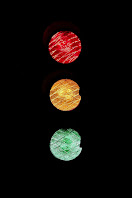Traffic light: Working and application
How Do Traffic Lights Actually Work? How Can We Build One?
Ever Wondered Why You Wait at a Red Light Even When the Road Is Empty?
Traffic lights are more than just blinking bulbs — they’re part of a carefully engineered traffic control system that keeps people safe and roads organized. But how do these systems actually work? And better yet — can you build your own traffic light system at home?
Yes! And you don’t need a city contract to do it — just an Arduino and a few LEDs.
Let’s explore:
-
How real-world traffic lights work
-
The science behind sensor-based systems
-
How to build your own Arduino-powered traffic light
1. Timer-Based Traffic Lights (Traditional)
-
Pre-programmed cycles: Red, green, yellow for fixed durations.
-
No sensors involved.
-
Still widely used in small towns or low-traffic intersections.
Problem: You wait even when no one's coming.
2. Sensor-Based Traffic Lights (Smart Systems)
Modern cities use dynamic traffic control systems:
Inductive Loop Sensors
-
These are loops of wire buried under the road.
-
When a car stops over it, its metal disturbs the magnetic field.
-
The controller knows: "Hey! There's a car here. Let’s turn green soon."
Microcontrollers/PLCs
-
Devices like Arduino (in small scale) or industrial PLCs (real-world) process sensor data.
-
They control the lights in real time.
Cameras or IR Sensors
-
High-tech cities use image processing or infrared sensors to detect vehicle flow, pedestrians, and even emergency vehicles!
Adaptive Light Timing
-
Green light duration changes based on real-time vehicle count.
-
Common in metros and intelligent traffic systems.
Main Components Used in Real Traffic Systems:
Objective:
Simulate a simple traffic signal that cycles through Red → Yellow → Green repeatedly, just like a real intersection.
Components Needed:
What You Learn from This Project
- Pin control & sequencing in Arduino
- Basic traffic logic implementation
- Real-world engineering concepts in a small scale
Advantages of This Project
Ways to Upgrade
Real-Life Use Case Example:
Let’s say you want to install a traffic signal at your college gate for safety during high foot traffic hours. You can:
-
Use this logic on a larger scale
-
Add a motion sensor to detect people or vehicles
-
Control it all via Arduino + relay module + 12V LEDs
And boom — your Arduino project just became a real-world solution.
Traffic lights may seem boring — until you realize they’re logic systems running in real time. With Arduino, you can simulate this behavior and understand traffic control from the inside out. Whether you're a beginner or a pro, this project is a perfect gateway into smart systems.
Watch our YouTube Shorts on Arduino Traffic Lights to see it in action!











Comments
Post a Comment